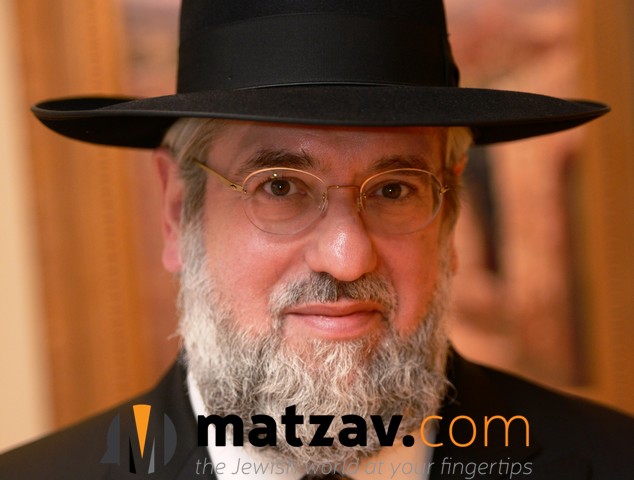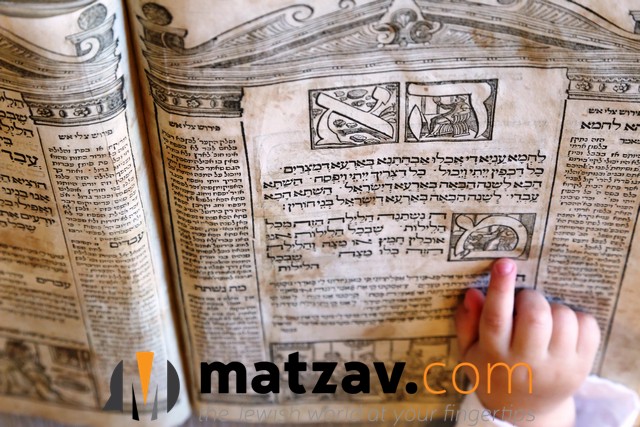
By Rabbi Pinchos Lipschutz
A young boy sat with his father in Auschwitz reciting what they could remember of the Haggadah on the Seder night. As they sat in the world’s most dismal corner, during the darkest of times, their minds were elsewhere.
Imagine them holding a Seder in Auschwitz, a father and son hiding, shuddering from hunger, fright and exhaustion. As they attempted to recall the memories of Sedorim in years past, at home, with the atmosphere festive, beautiful faces of gathered family around the decorated table, the emaciated boy with his scarecrow of a father commemorated the redemption.
The boy asked the four questions of Mah Nishtanah and, when he was done, asked a fifth.
“Tatte leben ich vil dir fregin… I have one more question. Will we be alive next year, me and you, so that I can ask you the questions again?”
The father turned to the boy and said, “Look all around us. We don’t know what tomorrow will bring. There is no way to know what our fate is. But one thing I do know, my dear son: Whether or not we will live until next Pesach, you can be sure that next year there will be boys all around the world asking their fathers the Mah Nishtanah.”
 The accompanying image signifies that message. My three-year-old grandson points with excitement at the Mah Nishtanah in a Haggadah printed 387 years ago.
The accompanying image signifies that message. My three-year-old grandson points with excitement at the Mah Nishtanah in a Haggadah printed 387 years ago.
As you look at the image, imagine all the Sedorim that Haggadah was present at. Think of all the years of joy and happiness and also those of deprivation, pogroms, sadness and the Holocaust.
And think that all those 387 years, no matter what was going on, boys were asking their fathers the Mah Nishtanah. And 387 years later, Jewish boys the world over are still asking the Mah Nishtanah and their fathers are providing answers to their questions.
Everyone, on their own level, eagerly awaits this Yom Tov of geulah, Pesach. We await Eliyohu Hanovi’s appearance on this night and his announcement of Moshiach‘s arrival. We feel blessed to welcome him as the children gauge how much wine he really drank from his regal cup.
We sit resplendent at the Seder, rejoicing in our exit from servitude, and every year we celebrate again with feelings of joy and gratitude.
And just as we do in our homes of plenty, without fear of blood libels or pogroms, the father in Auschwitz was explaining to his son that they were links in a glorious chain stretching back to the time our nation was formed – Arami oveid avi and Avodim hoyinu – when the Jews were slaves in Mitzrayim.
That same nation of downtrodden Jews was lifted and charged with a mandate at Har Sinai. We were all there as Hashem proclaimed, “Anochi,” and, “Lo yihiyeh lecha.” We rose from pitiful and exhausted castaways to embraced members of Hashem’s nation, and no matter what happens, that chain will continue extending, link by link, forever. Parents charge their children and pass on to them the torch of the eternal flame that will illuminate the world until the final day of golus, when the world will burst forth with the light of the Ohr Chodosh.
We recite in the Haggadah, “Bechol dor vador,” reminding us that it is a generational thing. We say, “Bechol dor vador chayov adam liros es atzmo ke’ilu hu yotzah miMitzrayim – In every generation, everyone must see themselves as if they were redeemed from Mitzrayim.” We then say, “Bechol dor vador omdim oleinu lechaloseinu – In every generation, the nations of the world attempt to annihilate us, but Hashem saves us from their plots.”
We are stating that the plot of the Mitzriyim was not a one-time thing. What transpired then has been repeated many times. In fact, in each generation, nations seek our demise and therefore, in each generation we must view ourselves as if we were redeemed, because, in fact, we were.
So when we sing Vehi She’omdah, we celebrate those generational victories that took place in every generation, going back to Avrohom Avinu and his travails, and until the modern day, when the Arabs, Iran and others who seek our annihilation are neutralized.
We don’t just sing for our own good days or for the victories that took place in our generation. We sing for them all, going back to the beginning, because we are not just individuals. We are not just families. We are not just the people around our table. We are all part of something much bigger than us and our times. We are part of a large movement that stretches back thousands of years.
During the Seder, our essence shines as we perceive how big we really are. On this night, we leap past our homes, past our barriers, past Auschwitz and the endless stream of ghettos, prisons, cellars and dungeons in which we have found ourselves. On this night, we leap past everything that was erected to hold us back and keep us down, and as we rise, we tap into our essence. We eat bread that hasn’t risen, because we have.
The posuk (Bereishis 26) relates that Yaakov Avinu brought two goats to his father, Yitzchok, as he asked him for his eternal blessing. Pirkei D’Rebbi Eliezer (Chapter 32), cited by Rashi (Bereishis ibid.), asks why Yitzchok required two whole goats for his meal, explaining that the story transpired on the eve of the Seder, and one goat was for the Korban Pesach while the second was for matamim. The Baal Haturim and others explain that matamim refers to the korban chagigah. Thus, the two goats were for the two korbanos that are brought on Erev Pesach.
The Vilna Gaon adds that the bread Yaakov brought for Yitzchok was matzoh and the wine was for the Arba kosos.
The Gaon ties the song of Chad Gadya to this early Seder. He explains that Chad Gadya is a story of two goats, which is why we recite the words Chad Gadya twice. They refer to the two goats that Yaakov brought to his father,.
Our Sedorim hearken back to the Seder of Yitzchok and Yaakov, and we sing this song to remind us that we are part of something larger than us. We are links in a chain stretching through the ages back to Avrohom, Yitzchok and Yaakov. If we listen to that message, we will be blessed, as Yaakov was, with all the good this world has to offer.
The Rambam writes that it is a mitzvas asei to tell the story of our departure from Mitzrayim on the first night of Pesach. He states (Hilchos Chometz Umatzah 7:1) that this mitzvah is derived from the posuk (Shemos 13:3) which says, “Zachor es hayom hazeh asher yotzasa miMtzrayim – Remember this day that you left Mitzrayim.” How do we know that this posuk is referring to the night of the 15th of Nissan? Because the posuk states (Shemos 13:8), “Vehigadeta levincha bayom hahu leimor baavor zeh – And you shall tell your son, ‘On that night…’” Which night is it? The night when you have pesach, matzah and maror placed in front of you.
The Rambam adds that even if you do not have a child, and even if you are in the company of great Torah scholars, you are still obligated to discuss the redemption from Mitzrayim.
We can explain that although the Torah delivers this mitzvah in verses pertaining to a father-son discussion, the talk must take place no matter who is there, even if it is people who are well-versed in what transpired and do not need to be taught the story or the halachos of Pesach. This is part of the obligation to realize that the Seder we are sitting at is not merely for us and our families, but to remind us of who we are, where we come from, and what our mission is.
The famed Yerushalmi maggid, Rav Shalom Schwadron zt”l, would speak every Friday evening at the Zichron Moshe shul in Yerushalayim. As in times of old, hundreds would come from all over to sit in the shul and bask in the glow of the famed darshan. His performance was the talk of town. One minute the audience would be rolling from laughter and the next they would be overcome with emotion, puddles of tears forming on the well-worn stone floors of the historic shul.
One day, the Brisker Rov passed Rav Schwadron on the street. He said hello and inquired about his welfare. Then he asked him what he spoke about the past Shabbos in Zichron Moshe. Rav Shalom told him the topic.
“Was there a big crowd?” the rov asked.
“Oh, yes,” said Rav Shwadron. “Huge. There were like 5 to 6 hundred people there.”
“And tell me,” asked the rov, “was Rav Shalom also there?”
Rav Schwadron would repeat the story and marvel at how brilliantly the Brisker Rov had rebuked him.
We talk to others and we become animated. We set people on the path, but we forget to pay attention to our message. At the Seder, we don’t only speak to our children, spouse and guests. We must also remember to speak to ourselves and pay heed to what we are saying.
It was this night that emboldened our forefathers wherever they were, injecting the kedoshim of the Inquisition, and the concentration camps, and the churban habayis, and all other catastrophes, small and colossal, with an awareness that they would persevere, because the am hanetzach has a past and a future.
A wise woman gave my son advice this past Shabbos. She said, “Always know who you are.”
So many of us are lost and thrashed about because we don’t know who we are. We don’t understand our greatness, giving up on ourselves before we even have a chance to get anywhere in life.
Sadly, you see such children everywhere in our world, empty and vacuous as they chase thrills and seek enjoyment while their goal escapes them. There is no joy in idle pursuits. There is no happiness in running from who you are. Life has many challenges. Those who remember who they are, where they come from, and what they are all about are able to persist and realize their missions.
So how do we reach those children and how do we bring them back? What do we say to them? How do we express to them the hopes and dreams we brought them up with? How do we let them know that even though they may not believe in themselves, we believe in them?
The answer is through Torah. It sounds like a cliché, but it’s not. Love them and show them that you love them. Speak to them on their level, in a voice they can understand and with words they can accept. Communicate.
That is what the Seder is all about. We have a question-and-answer discussion about supremacy and grandeur, but also about being in the dumps and climbing out. The children question and the parents respond.
At the Seder, we recite the Mishnah that states, “Kineged arba bonim dibra Torah.” The Torah speaks to all types of kids: the smart ones, the wicked ones, the dimwitted ones, and even the ones who are clueless. And for each one, there is a proper answer, which speaks to that child in a way that he can grasp and understand. For each, there is a response that leads him to be able to answer the question of who he is.
We, adults, though fortunate to live in safety and comfort, sometimes forget who we are. At the Seder, we announce to our children and ourselves what we represent, who we are, where we come from, and where we are going.
If we feel it, they will feel it, too, carrying that torch for generations to come, until the great day. Leshanah haba’ah b’Yerushalayim habenuyah.
When the town of Chust was overtaken by the Nazis, the rov, Rav Yehoshua Grunwald was given one last opportunity to speak. It was on the first day of Pesach that he faced his people for one final time.
He stood in front of them and quoted the words in the Haggadah, “Hoshata hacha leshanah habaa barah d’Yisroel.” We proclaim, “This year we are here. Next year we will be in Eretz Yisroel.”
Why do we say Hoshata hacha; is it not obvious that we are here? We wouldn’t be here if we weren’t here.
The Chuster Rov cried out to his people, “Hashata hacha! Hashata hacha!” yes, we are saying something, we are proclaiming that we are still here. The Haggadah reminds us that we are still here. Despite all that has come over us, we are still here. Despite all that has come over us, we are still Hashem’s nation, still holding on.
If we focus on that message, then soon we will be “b’arah d’Yisroel.”
If enough of us know who we are, how we got here and where we are going, by next year we will be in Eretz Yisroel, geulim.
May Eliyohu arrive speedily and bring with him the neshamos of our departed loved ones, the boys and girls, the men and women, who faithfully sang Vehi She’omdah as they awaited the arrival of the final redemption.
{Matzav.com Newscenter}











